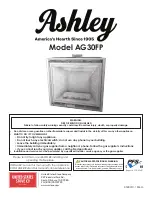
20
Quadra-Fire • EXCURSION-I, EXCURSION-II, EXCURSION-III Owner’s Manual • 2538-981 Rev. B • 2/19
Burner Ignition and Operation
Frequency:
Annually
By:
Qualified Service Technician
Tools needed:
Protective gloves, vacuum cleaner, whisk
broom, flashlight, voltmeter, indexed drill bit set, and a
manometer.
• Verify burner is properly secured and aligned with pilot
or igniter.
• Clean off burner top, inspect for plugged ports, corrosion
or deterioration. Replace burner if necessary.
• Replace Glowing Embers
®
with new dime-size pieces.
DO NOT
block ports or obstruct critical lighting paths.
Refer to appliance installation manual for proper ember
placement.
• Verify batteries have been removed from battery back-up
IPI systems to prevent premature battery failure or
leaking.
• Check for smooth lighting and ignition carryover to all
ports. Verify that there is no ignition delay. Inspect and
ensure the lighting of the main burner occurs within four
seconds of the main gas valve opening.
• Inspect for lifting or other flame problems.
• Verify air shutter setting is correct. See Installation
Manual for required air shutter setting. Verify air shutter
is clear of dust and debris.
• Verify vertical restrictor setting is correct. See Installation
Manual for required vertical restrictor setting.
• Inspect orifice for soot, dirt and corrosion. Verify orifice
size is correct. See Service Parts List for proper orifice
sizing.
• Verify manifold and inlet pressures. Adjust regulator as
required.
• Check all accessible gas-carrying tubes, connections,
pipes and other components for leaks.
• Inspect pilot flame pattern and strength. See Figure 4.6
for proper pilot flame pattern. Clean or replace orifice
spud as necessary.
• Inspect
IPI flame sensing rod for soot, corrosion and
deterioration. Polish with fine steel wool or replace as
required.
• Verify that there is not a short in flame sense circuit
by checking continuity between pilot hood and flame
sensing rod. Replace pilot as necessary.
Figure 4.6
IPI Pilot Flame Patterns















































